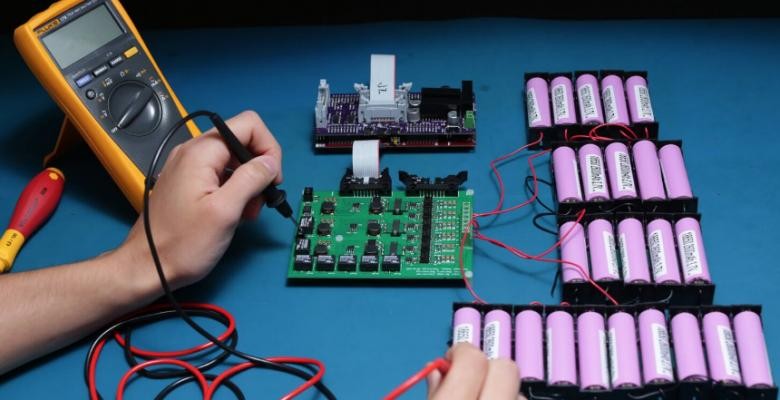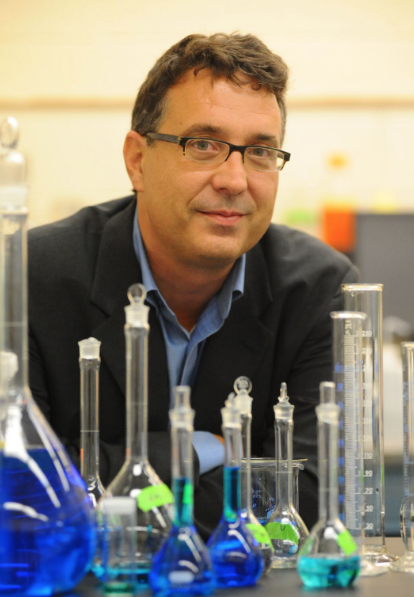CleanTech: Designing Batteries for a Sustainable Future

As director of Columbia’s newest research arm, the Columbia Electrochemical Energy Center, Alan West leads a team developing batteries that can store solar and wind-powered energy.
The need is greater than ever. “Unlike fossil-fuel powered plants that produce electricity on demand, renewables like wind, solar and water require storage solutions on an unprecedented scale,” said West, the Samuel Ruben-Peter G. Viele Professor of Electrochemistry and chair of the Department of Chemical Engineering. “Storage in the form of batteries is crucial to the integration of wind and solar onto the electrical grid.”
The Center is a collaboration of five departments at the Engineering School and draws on expertise at the Earth Institute, Lamont-Doherty Earth Observatory, the Center for Global Energy Policy and Columbia Technology Ventures. Its research ranges from the discovery of new materials for energy storage to learning how to use new technologies in complex systems such as the electrical grid.
“The breadth of our talent and resources allows us to rapidly evaluate concepts and prototype materials,” said West. “The potential we can tap by collaborating on the storage challenge is enormous.” West joined the Engineering School faculty in 1992. He has a Ph.D. in chemical engineering from the University of California, Berkeley.

On Nov. 19, some of the center’s researchers will be discussing their work at a CleanTech Innovation Showcase in Low Library, an all-day science fair hosted by Columbia Technology Ventures with the Engineering School, Lamont-Doherty and the Earth Institute. CTV, founded in 1982, is the University’s technology transfer office, working to identify and evaluate new scientific breakthroughs for potential commercialization, including patents and licensing deals.
“The Electrochemical Energy Center is a perfect example of starting with fundamental research, and moving to applications and implementation in partnership with entrepreneurs and industry,” said Satish Rao, CTV’s associate director of physical sciences licensing. “CTV is committed to creating market opportunities for the great clean technology research at Columbia.”
Topics for presentations at the Innovation Showcase include materials for sustainable energy storage, energy savings in multi-family residential buildings, innovative technologies for wastewater treatment, and low-cost fuel production. Besides Columbia students and researchers, the audience will include people from industry and the investment and economic development communities.
Michael Purdy, Columbia’s executive vice president for research, Mary Boyce, dean of the Engineering School, and Peter De Menocal, dean of science in the Faculty of Arts and Sciences, will be speaking at a panel about CleanTech at Columbia. A second panel, on the outlook for future innovation, will feature Arthur Lerner-Lam, deputy director of the Lamont-Doherty, and Dan Steingart, who will join the Engineering School faculty in January from Princeton University. A professor of chemical metallurgy, earth and environmental engineering and chemical engineering, Steingart will also be co-director of the Electrochemical Energy Center.
A third panel, with venture capitalists and a representative of the New York State Energy Research and Development Authority, will discuss clean tech investing.
West said the new center will encourage entrepreneurial activities as it develops energy storage technologies, and seeks industry involvement. It will have four priorities: Safe and rapidly chargeable batteries for electric vehicles; economical, sustainable large-scale battery or battery-like systems on the grid; reducing the cost of battery technologies in order to make electricity more available in the developing world; and researching how batteries are likely to be used in next-generation energy-efficient urban buildings.
New regulations and other mandates are encouraging the move to clean energy. In New York State, for example, a clean energy standard requires that 50 percent of the state’s electricity be generated through renewable sources by 2030, compared with about half that now. Consumers, too, demand clean energy. Last year, more than one million electric cars were sold globally, a number that will rise over coming decades. While such batteries may be large enough to provide electricity for a single-family home, multi-family dwellings and office buildings require more energy and batteries with exponentially larger storage capacity. And while parts of the developed world have plenty of sunshine and wind, they currently can’t afford the batteries needed to store the power that’s produced.
The new center can connect engineers with a wide range of technical expertise and research interests to industry leaders and government policy makers. It plans to study how battery systems interact with other efficient technologies, including thermal storage, and will draw on nearly a decade’s worth of data about solar-powered mini-grids.
“By establishing a multi-disciplinary center dedicated to batteries and fuel cells, we are making a commitment not only to renewable energy and the associated need for energy storage, but to the larger goal of a more sustainable humanity,” said Mary Boyce, dean of Columbia Engineering.